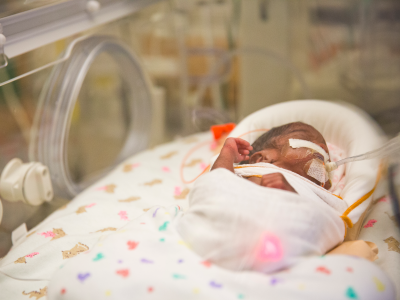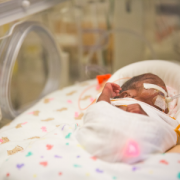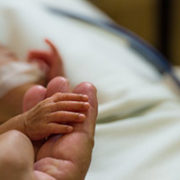Children’s National NICU reduces chest x-rays, unintended extubations

Children’s National is taking the lead in safety and quality improvement by initiating two protocols in its neonatal intensive care unit (NICU) aimed at reducing chest X-rays and unintended extubations (UE). Through these efforts, the Neonatology and Radiology divisions have decreased the X-ray radiation dose levels to as low as reasonably achievable (ALARA), reduced the number of unintended extubations, and found significant cost-savings. Notably, the Children’s National team was awarded an Honorable Mention for their abstract submission on UE efforts at the Children’s Hospitals Neonatal Consortium Quality Symposium in September.
Evaluating effectiveness of the chest x-ray
Chest X-rays in the NICU are one of the top five unnecessary tests, according to the American Academy of Pediatrics. While they may be used to help with procedures, such as verifying placement of endotracheal tubes (ETT) and central venous catheters, they don’t increase efficacy or safety, and they have been found to increase the use of hospital resources.
There were concerns of an increased incidence of UEs and potential excess radiation exposure, and that’s when the NICU team at Children’s National developed a new protocol. It restricted the use of routine chest X-rays used to confirm ETT placement for all stable intubated patients.
Chest X-rays are now performed twice a week, instead of daily, or following a change in status, for stable ventilated patients. The team realized that daily chest X-rays might not be needed and that reducing their frequency would also decrease the likelihood of patients self-extubating during the procedure. Dropping the additional procedures was believed to be non-disruptive.
To measure the effectiveness of the new protocol, the team used Trendstar billing data to track the number of single chest X-rays for all NICU patients per patient day. It also used that data to show the total net charge for a single chest X-ray.
Taking measures to decrease unintended extubations
Unintended extubations are the fourth most common event in the NICU and are associated with hypoxia, ventilator-associated pneumonia, intraventricular hemorrhage, code events, and increased length of stay. In fact, UEs almost double the length of stay versus patients who do not experience UEs, and the cost of care increases by $34,000 per patient.
Realizing these detrimental effects, the Children’s NICU team launched a quality improvement project to reduce UE rates from a median of 0.6 events to less than 0.3 events per 100 vent days, and in turn its associated complications, by December 2016.
To accomplish this, the staff and stakeholders formed the Stop UNintended Extubations (SUN) Team to address key drivers such as consistent taping and re-taping practices, appropriate sedation of patients, standardizing practices around moving intubated patients, and more. The team designed and tested a UE Rick Scale to assess the likelihood of extubation, and each key driver was assigned several actionable interventions for high-risk patients to escalate and address cases prior to potential UE events. Interventions included team safety huddles and debriefs, risk reports, staff education, tube placement corrections, and taping standards among others.
The outcomes
The new X-ray protocol reduced the rate of chest X-rays and showed a 27 percent cost-savings for babies with longer NICU stays. The change also decreased the patient radiation doses to ALARA. The team will continue to track the data as it will review the rates again in December 2016.
The UE quality initiative calculated UE rates based on the number of total ventilator days less the number of tracheostomy days. Within a month of starting the project, the unintended extubation rate decreased from 1.18 to .59 events per 100 vent days. Within five months, the NICU reached its lowest rate below their benchmark median at 0.41 events per 100 vent days, and the number of days between events increased from a high of days prior to the project to a high of 33 days. The team continues to test the UE Risk Scale in order to validate it for external use.









